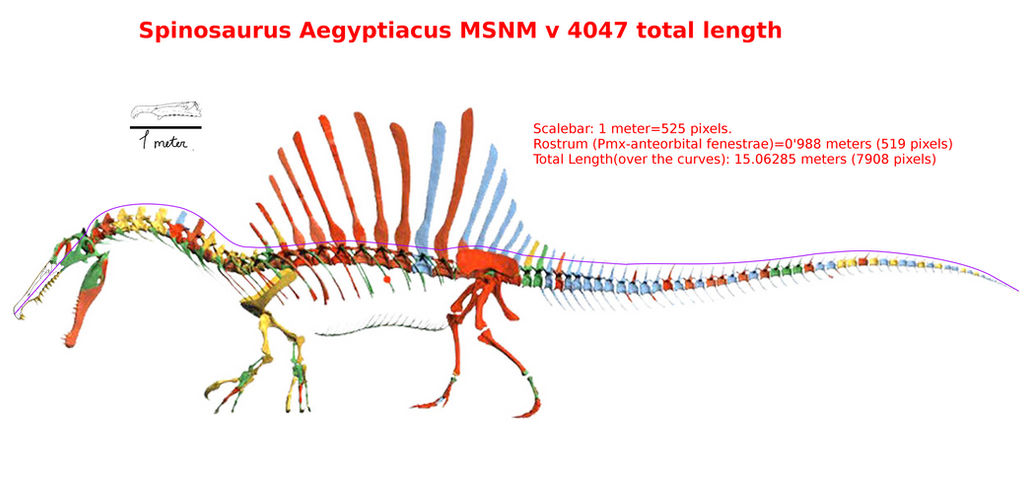Deviation Actions
UPDATE 10/02/2019:
This estimation was in need of an update for a long time. Lots of things have happened since I first produced the first estimate, which was also my first GDI ever. I produced my own lateral view of the skeletal, for an in depth discussion about the taxon and for clearing some doubts about how it was produced, please take a look at it and it's description:

For the first iteration of the model, the lateral view was simply an adaptation of the figure in the Ibrahim et al 2014 supplementary materials scaled to the size of the MSNM v 4047 rostrum, but the fit wasn't as perfect as I would have liked. This new lateral view should be more rigorous.
A second important update has been the production of a dorsal view. First, I used the preserverd fossils of IPHG 1912 to infer the shape of the ribcage and cross sections of it to infer the width, as well as other spinosaurid and megalosaurid specimens to infer the rest of the body, following a similar approach to Ibrahim 2014 and also a similar one to anyone that tries to restore the skeleton of a dinosaur. The result was compared with a top view of the model constructed by Ibrahim and colleages for their 2014 paper (the width of the ribcage matched perfectly) and other body sections were slightly updated. The resulting model being this:
The third update concerns the density. Many people has (rightfully) noted that the density used for Spinosaurus was too low for what the very dense and compact bones indicate (similarly compact to those of penguins, suggesting an overal similar global density to those, and and overall reduced pneumacity, just as penguins have). A high density, comparable to that of wáter, has been used for the new model.
With no further dilation, here are the new results.
Conclusion: in this, more accurate and true to the bone measurements Spinosaurus model the volume is reduced (6912 dm^3 compared to 8150 of the old model), but the increased density makes it so the difference with the previous estimation is only 681 kg for MSNM v 4047. The mass of 6876 kg fits nicely within the upper end of the range calculated by Ibrahim and colleages for their volumetric mass model (6000-7000 kg).
OLD JOURNAL:
Description of the method:
Graphical double integration performed by Matblab program.
We calculated the mass of the North african theropod dinosaur Spinosaurus aegyptiacus, using a graphical double integration method. We believe GDI is in itself, and without a doubt, one of the best methods to calculatte the mass of extint organisms, and the best that can be used using a multi views silhouette from the animal. The method averages a big amount of eliptical sections to aproximate the volume of a complex 3D object. The more eliptical sections, the more accurate the result will be, when a number of slices made is surpassed the result will be almost real life-like.
This matlab program utilizes digital image processing technology to analize two silhouettes from different views. It counts the number of non white pixels in every pixel-wide column from the image, and produces one slice per pixel. In response, the program is extremely sensitive to irregularities in the silhouette's perimeter.
This all means that being the torso 910 pixels long in axial length, the program produced 910 slices, and thus 910 eliptical sections for the torso, preserving the shape of the silhoettes intact in the process, and being as accurate as it can be from a mathematical point of view (when using this GDI method).
We associate the error bars to the human factor when drawing the silhouettes, and the non exact numbers for the density figures.
Figures used:
The densities aim to replicate those used by the renowned paleontologist and paleoartist known as Scott Hartman, owner of www.skeletaldrawing.com. Theese average density figures were the ones he used for calculating the mass of other two big Cretaceous theropods; Tyrannosaurus and Giganotosaurus. We did this because we intended our spinosaurus stimate to be fairly comparable to theese other stimates.
The silhouette for the Spinosaurus was made using the proportions suggested by Ibrahim et al (2014). The silhouette itself was made by RandomDinos, giving the Spinosaurus a similar amount of added soft tissue to that of Hartman's reconstructions of Giganotosaurus and Tyrannosaurus.
The dorsal view was infered from the 3D models from Ibrahim et al and anterior views from the composite Spinosaurus mount, which is now housed at Berlin's Museum für Naturkunde. The result is a barrel- like chested Spinosaurus. The gastrila was repositioned and as a result the torso got a more rounded shape compared to Ibrahim's totally speculative figure.
What we don't intend to do:
We don't inted to do an study of Spinosaurus lifestyle, locomotion, stance, biomechanis, or swimming or fighting capabilites. This is purely an study on the dimensions of the animal, linear measurements and specially and more importantly, mass.
Although the results of this study can be used by anyone as he pleases and for any kind of study/ investigation that person wants to make.
Example of the matlab script working: (The results at the end are for the torso of Giraffatitan Brancai)
Silhouettes used:
Forearms: (Anterior/Lateral views)
Torso: (Dorsal/Lateral views)
Tail: (Dorsal/ Lateral views)
Sail: (Dorsal/Lateral views)
Hindlimbs (distal): (Anterior/Lateral views)

We used a 15,16 meters long spinosaurus for the study. For it, the results went as follows.
FOR THE HYPOTHETICAL 15,16 METERS LONG SPINOSAURUS:
Total length (axial)= 14,80 meters
Total length (Over the curves)= 15,16
Total mass: 7708, 54 kgs (~7.7 tonnes)
However, then we scaled Ibrahim's model using MSNM v 4047 rostrum, which includes premaxila, maxilla, and rostral part of the nassals (988 mm) ( Dal sasso; 2005). And we got a result of 15,063 meters total length for the Spinosaurus Aegyptiacus biggest referable specimen. So we isometrically scaled the 15,16 meters results for a 15,063 spinosaurus. The accuracy of the results remains unchanged, since isometrical scale equations for the same model don't have error bars associated to them.
Spinosaurus total length calculation:
FOR THE LARGEST REFERABLE SPECIMEN TO SPINOSAURUS AEGYPTIACUS; MSNM v 4047. (Definitive results)
Total length measurement for MSNM v 4047: 15,06 meters. ~15,1 m
Mass for 15,06 meters: 7557 kgs. (~ 7.6 tonnes)
Compiled values for each body part:
A link for Randomdinos version of this:
Weighing the Fisher King - biggest... or is it?Spinosaurus aegyptiacus has, for quite a long time (the furthest I can trace it in scientific papers is 2005, but we all know what Jurassic Park /// was like), been described as the biggest theropod that ever existed. Even the, rather, well, dramatically updated version given by Ibrahim et al. (2014) didn't seem to spark the paleocommunity into doubting this perpetual title.
But should we really be repeating that claim?
Most methods to estimate dinosaur weights are, of course, rather imprecise, and references are often difficult to find. Double Graphic Integration (GDI) is currently the, well, least inaccurate of possible methods, but I've never had the capability to do it on my own.
However, Franoys recently proposed that we should work on one of those together, and (much to my surprise) he had the mathematical skills necessary to create a program that could do it for us. I don't want to expand too much on this, as maths aren't a field I enjoy working with, but for such things you can
Special thanks to my girlfriend, who helped me inmensely with all of this and she worked as much as Randomdinos and I, but she doesn't own a Deviantart account. So a big shoutout to her! Her programming and image-analizing skills have been proven as very good and useful. I love and admire her so much.
Amphicoelias fragillimus redescribed
Tyrannosaurus rex size.
Mathematical analysis on Carcharodontosaurus mass
A mathematical analysis on Tyrannotitan mass.
Pretty outdated today








